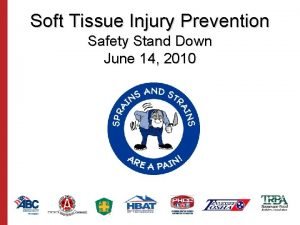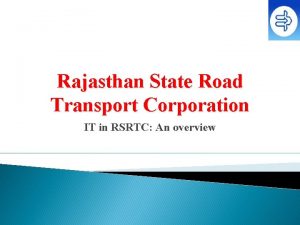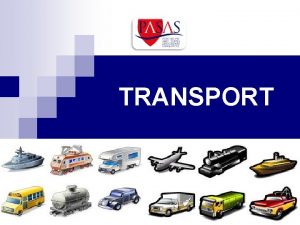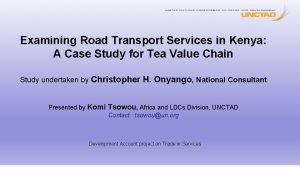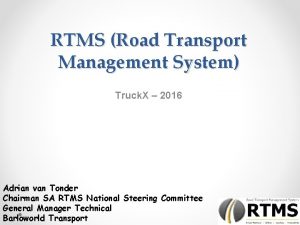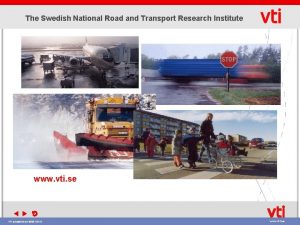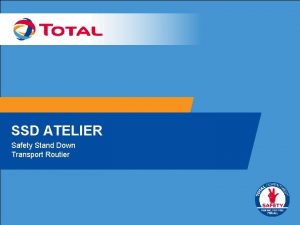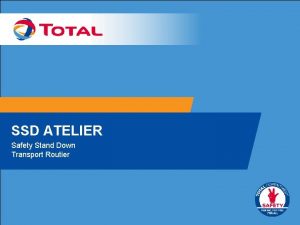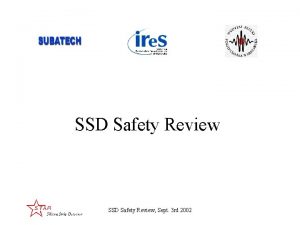SSD WORKSHOP Safety Stand Down Road Transport WORKSHOP









- Slides: 9

SSD WORKSHOP Safety Stand Down Road Transport

WORKSHOP FRAMEWORK WHY • Create an opportunity to talk with our drivers about serious road traffic accidents. • Highlight and discuss potential accident root causes incl. weaknesses in our organisation. • Together with our transporters and drivers, identify improvement insights. WHAT • Understand how participants manage the risks associated with their journeys. • Launch a discussion focused on road safety and make sure it keeps going. WHO • Total leads the organisation of the workshops, hand in hand with transporters. • Duets made of Total and transporter representatives facilitate the discussion. HOW • During 45 min-1 hr, two facilitators debate with a group of 20 drivers. • With the help of a facilitator’s presentation and guide. • From the events repository, select a case that will be used to start the discussion. TOTAL Classification: Restricted Distribution TOTAL - All rights reserved

WORKSHOP SEQUENCE Get prepared (Before) Get started (5 min) • Meet your duet facilitator upfront and decide roles repartition. • From the events repository, select a case to be described and discussed. • Imagine step by step how the workshop could unfold. • Introduce yourself and thank the participants for attending. • Explain the objectives of the session. • Remind basic workshop rules: no phone, no judgement, no criticism, listening to others. • Explain that expressed views will be treated anonymously. Provide information (5 -10 min) • Present in detail the road transport accident chosen from the events repository. • Take questions from the audience as necessary. TOTAL Classification: Restricted Distribution TOTAL - All rights reserved

WORKSHOP SEQUENCE Encourage the group (25 -30 min) • • Summarize (5 -10 min) • Feed the main ideas mentioned back to the group : « If I understood well…» . • List the proposals that were made along the discussion. • Ask participants which safety related questions they would like to ask. Wrap up (5 min) Followup (After) Request participants opinions : « What do you think about this accident ? » . Repeatedly ask the question « Could it happen to us ? » . Use additional questions to maintain the discussion. Take notes of key ideas and main suggestions expressed. • Remind the importance of driver’s work and role for Total. • Remind the importance to work hand in hand with transporters. • Thank the participants for their insights and close the session. • Consolidate information from various workshops and identify trends / frequent topics. • Share the consolidation within the Affiliate and / or HQ if deemed necessary. TOTAL Classification: Restricted Distribution TOTAL - All rights reserved

WORKSHOP FACILITATION 101 AS A FACILITATOR Your objective is to understand how participants manage the risks associated with their journeys. Your role is to launch a discussion focused on road safety and to make sure it keeps going. TO DO • Explain that expressed views will be treated anonymously. • Remain neutral and benevolent. • Create a safe climate where participants can raise issues without fearing adverse consequences. • Let the participants talk to each other directly. • Encourage each participant to talk and express views. • Reformulate : « If I understand well…? » . • Ask a question to one of the participants. TOTAL Classification: Restricted Distribution TOTAL - All rights reserved

WORKSHOP FACILITATION 101 NOT TO DO • • Make judgements, take sides. Provide your own point of view / your own solutions. Rush into an action plan oriented session without listening about situations first. Ask several questions in a row without allowing sufficient time for answers. Interrupt a participant. Feel personally accused and justify. Share your own thoughts, hypothesis or suggestions. Ask questions to the overall audience and expect immediate reactions. TOTAL Classification: Restricted Distribution TOTAL - All rights reserved

POSSIBLE QUESTIONS (OPTIONAL) Can you describe your last trip ? For you, what is a good day / bad day on the road ? When was the last you were frightened on the road ? If you had a magic wand, what would you change in your daily job ? On the road, when was the last time you witnessed an accident ? What could be the story leading to the next severe road transport accident ? Which preoccupations keep you awake at night ? Which accident scenario do you fear the most ? According to you, what is a good driver ? TOTAL Classification: Restricted Distribution TOTAL - All rights reserved

TRICKS & TRAPS USEFUL TRICKS • Use silence as an ally: unsease often unlocks speech. • Still nobody willing to answer ? Designate a « volunteer » . • Thereafter allow this volunteer to designate the next volunteer and so on. • Alternate between facilitators to make the session more alive. • A facilitator takes notes while the other keeps the discussion going. • Play the devil’s advocate: « Is everybody sure that…? » , « Is that so ? » , « Does everybody agree with this ? » , « Are you sure that this is sufficient to avoid accidents ? » , « Do you really think that…? » . TOTAL Classification: Restricted Distribution TOTAL - All rights reserved

TRICKS & TRAPS TO AVOID • Pay attention to « positive » statements only and disregard bad news. • Try to establish a general consensus / « We should all agree at the end » approach. • Put a participant in difficulty in front of his peers. • Start questions with « why » : it usually triggers self justification attempts. • Point fingers, blame individuals and / or consider sanctions based on expressed views. TOTAL Classification: Restricted Distribution TOTAL - All rights reserved



